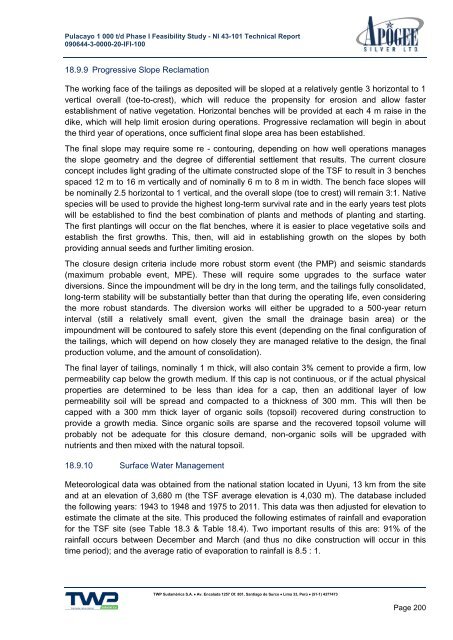Pulacayo Project Feasibility Study - Apogee Silver
Pulacayo Project Feasibility Study - Apogee Silver
Pulacayo Project Feasibility Study - Apogee Silver
Create successful ePaper yourself
Turn your PDF publications into a flip-book with our unique Google optimized e-Paper software.
<strong>Pulacayo</strong> 1 000 t/d Phase I <strong>Feasibility</strong> <strong>Study</strong> - NI 43-101 Technical Report<br />
090644-3-0000-20-IFI-100<br />
18.9.9 Progressive Slope Reclamation<br />
The working face of the tailings as deposited will be sloped at a relatively gentle 3 horizontal to 1<br />
vertical overall (toe-to-crest), which will reduce the propensity for erosion and allow faster<br />
establishment of native vegetation. Horizontal benches will be provided at each 4 m raise in the<br />
dike, which will help limit erosion during operations. Progressive reclamation will begin in about<br />
the third year of operations, once sufficient final slope area has been established.<br />
The final slope may require some re - contouring, depending on how well operations manages<br />
the slope geometry and the degree of differential settlement that results. The current closure<br />
concept includes light grading of the ultimate constructed slope of the TSF to result in 3 benches<br />
spaced 12 m to 16 m vertically and of nominally 6 m to 8 m in width. The bench face slopes will<br />
be nominally 2.5 horizontal to 1 vertical, and the overall slope (toe to crest) will remain 3:1. Native<br />
species will be used to provide the highest long-term survival rate and in the early years test plots<br />
will be established to find the best combination of plants and methods of planting and starting.<br />
The first plantings will occur on the flat benches, where it is easier to place vegetative soils and<br />
establish the first growths. This, then, will aid in establishing growth on the slopes by both<br />
providing annual seeds and further limiting erosion.<br />
The closure design criteria include more robust storm event (the PMP) and seismic standards<br />
(maximum probable event, MPE). These will require some upgrades to the surface water<br />
diversions. Since the impoundment will be dry in the long term, and the tailings fully consolidated,<br />
long-term stability will be substantially better than that during the operating life, even considering<br />
the more robust standards. The diversion works will either be upgraded to a 500-year return<br />
interval (still a relatively small event, given the small the drainage basin area) or the<br />
impoundment will be contoured to safely store this event (depending on the final configuration of<br />
the tailings, which will depend on how closely they are managed relative to the design, the final<br />
production volume, and the amount of consolidation).<br />
The final layer of tailings, nominally 1 m thick, will also contain 3% cement to provide a firm, low<br />
permeability cap below the growth medium. If this cap is not continuous, or if the actual physical<br />
properties are determined to be less than idea for a cap, then an additional layer of low<br />
permeability soil will be spread and compacted to a thickness of 300 mm. This will then be<br />
capped with a 300 mm thick layer of organic soils (topsoil) recovered during construction to<br />
provide a growth media. Since organic soils are sparse and the recovered topsoil volume will<br />
probably not be adequate for this closure demand, non-organic soils will be upgraded with<br />
nutrients and then mixed with the natural topsoil.<br />
18.9.10 Surface Water Management<br />
Meteorological data was obtained from the national station located in Uyuni, 13 km from the site<br />
and at an elevation of 3,680 m (the TSF average elevation is 4,030 m). The database included<br />
the following years: 1943 to 1948 and 1975 to 2011. This data was then adjusted for elevation to<br />
estimate the climate at the site. This produced the following estimates of rainfall and evaporation<br />
for the TSF site (see Table 18.3 & Table 18.4). Two important results of this are: 91% of the<br />
rainfall occurs between December and March (and thus no dike construction will occur in this<br />
time period); and the average ratio of evaporation to rainfall is 8.5 : 1.<br />
TWP Sudamérica S.A. Av. Encalada 1257 Of. 801, Santiago de Surco Lima 33, Perú (51-1) 4377473<br />
Page 200



